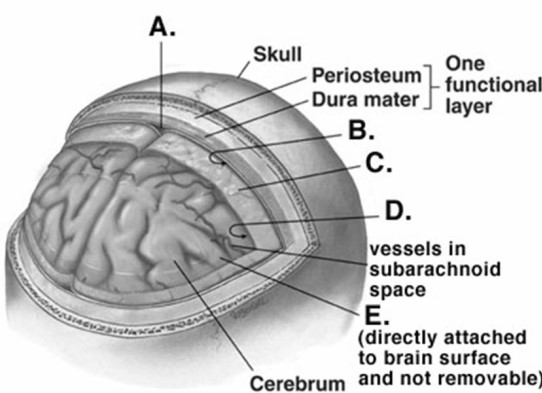A) temporal lobe
B) cerebellum
C) frontal lobe
D) occipital lobe
E) parietal lobe
G) A) and E)
Correct Answer

verified
Correct Answer
verified
Multiple Choice
Water-soluble molecules such as glucose and amino acids move across the blood-brain barrier by
A) diffusion.
B) endocytosis.
C) exocytosis.
D) mediated transport.
E) filtration.
G) B) and D)
Correct Answer

verified
Correct Answer
verified
Multiple Choice
Which of the following basal nuclei is located in the cerebrum?
A) subthalamic nucleus
B) red nucleus
C) caudate nucleus
D) substantia nigra
E) habenular nuclei
G) B) and C)
Correct Answer

verified
Correct Answer
verified
Multiple Choice
The inferior colliculi
A) are an integral part of the cerebrum.
B) are involved with auditory pathways in the CNS.
C) interconnect directly with the eye.
D) are a major CNS motor neurotransmitter group.
E) are located in the pons.
G) C) and D)
Correct Answer

verified
Correct Answer
verified
Multiple Choice
 -This is a midsagittal section of the right half of the brain.What does "D" represent?
-This is a midsagittal section of the right half of the brain.What does "D" represent?
A) cerebrum
B) cerebellum
C) corpus callosum
D) diencephalon
E) brainstem
G) C) and E)
Correct Answer

verified
Correct Answer
verified
Multiple Choice
What is the large C-shaped mass of white matter that consists of nerve fibers that connect the two cerebral hemispheres?
A) corpus callosum
B) infundibulum
C) intermediate mass
D) vermis
E) gyrus
G) C) and D)
Correct Answer

verified
Correct Answer
verified
Multiple Choice
Smooth,flowing movements are the result of fine motor coordination in the
A) anterior vermis.
B) cerebellar peduncles.
C) lateral cerebellar hemispheres.
D) flocculonodular lobe.
E) arbor vitae.
G) A) and B)
Correct Answer

verified
Correct Answer
verified
Multiple Choice
Which ventricle is located between the two halves of the thalamus?
A) first ventricle
B) second ventricle
C) third ventricle
D) fourth ventricle
F) A) and C)
Correct Answer

verified
Correct Answer
verified
Multiple Choice
Match the function with the correct lobe of the brain. -occipital lobe
A) important in voluntary motor function
B) fifth lobe of the brain
C) plays an important role in memory
D) reception and integration of visual input
E) reception of most sensory input
G) A) and C)
Correct Answer

verified
Correct Answer
verified
Multiple Choice
 -This is a lateral view of the brain.What does "A" represent?
-This is a lateral view of the brain.What does "A" represent?
A) temporal lobe
B) cerebellum
C) frontal lobe
D) occipital lobe
E) parietal lobe
G) A) and E)
Correct Answer

verified
Correct Answer
verified
Multiple Choice
The superior colliculi receive input from the
A) eyes,skin,cerebrum and inferior colliculi.
B) inferior colliculi,pyramids,skin and red nucleus.
C) skin,ears,pyramids and cerebellum.
D) cerebrum,cerebellum,thalamus and inferior colliculi.
E) nose,tongue and inner ear.
G) A) and E)
Correct Answer

verified
Correct Answer
verified
Multiple Choice
 -What does "B" represent on the diagram of the skull and brain?
-What does "B" represent on the diagram of the skull and brain?
A) subarachnoid space
B) dural venous sinus
C) pia mater
D) arachnoid mater
E) subdural space
G) A) and E)
Correct Answer

verified
Correct Answer
verified
Multiple Choice
Which nerve has branches that extend to the thoracic and abdominal viscera?
A) facial nerve
B) vagus nerve
C) trigeminal nerve
D) glossopharyngeal nerve
E) accessory nerve
G) A) and E)
Correct Answer

verified
Correct Answer
verified
Multiple Choice
Damage to branches of the _____ nerve can interfere with normal speech.
A) facial
B) vagus
C) trigeminal
D) glossopharyngeal
E) abducens
G) A) and E)
Correct Answer

verified
Correct Answer
verified
Multiple Choice
The central sulcus separates the
A) two parietal lobes.
B) frontal and parietal lobes.
C) occipital and temporal lobes.
D) temporal and frontal lobes.
E) parietal and occipital lobes.
G) A) and B)
Correct Answer

verified
Correct Answer
verified
Multiple Choice
Cerebrospinal fluid fills the
A) subarachnoid space.
B) subdural space.
C) dural sinuses.
D) epidural space.
E) None of these choices is correct.
G) A) and B)
Correct Answer

verified
Correct Answer
verified
Multiple Choice
The "thermostat" or nucleus that monitors blood temperature is located in the
A) hypothalamus.
B) midbrain.
C) pons.
D) thalamus.
E) brainstem.
G) B) and D)
Correct Answer

verified
Correct Answer
verified
Multiple Choice
What type of white fibers connect areas of the cerebral cortex in the same hemisphere?
A) basal fibers
B) commissural fibers
C) projection fibers
D) association fibers
F) None of the above
Correct Answer

verified
Correct Answer
verified
Multiple Choice
During brain surgery,the superior portion of the postcentral gyrus of a patient is stimulated.What do you expect the patient to do?
A) Flex his fingers.
B) Talk to the surgeon.
C) Smile.
D) Feel pressure on his toes.
E) Move his hand.
G) A) and E)
Correct Answer

verified
Correct Answer
verified
Multiple Choice
The corpus callosum
A) consists of a broad band of gray matter.
B) is found at the base of the transverse fissure.
C) is a band of commissural fibers that connects the right cerebral hemisphere to the left cerebral hemisphere.
D) connects the frontal lobe to the occipital lobe.
E) connects the frontal lobe to the parietal lobe.
G) A) and D)
Correct Answer

verified
Correct Answer
verified
Showing 41 - 60 of 146
Related Exams